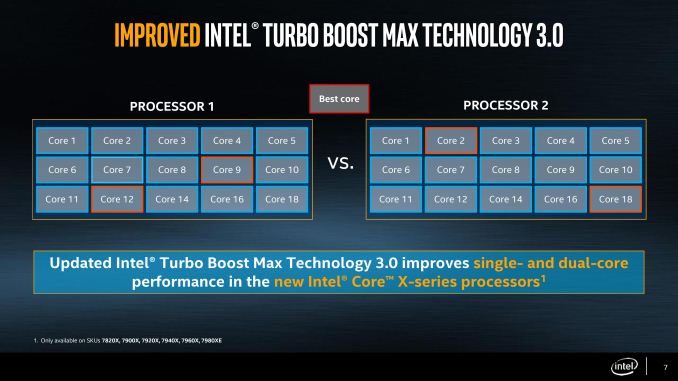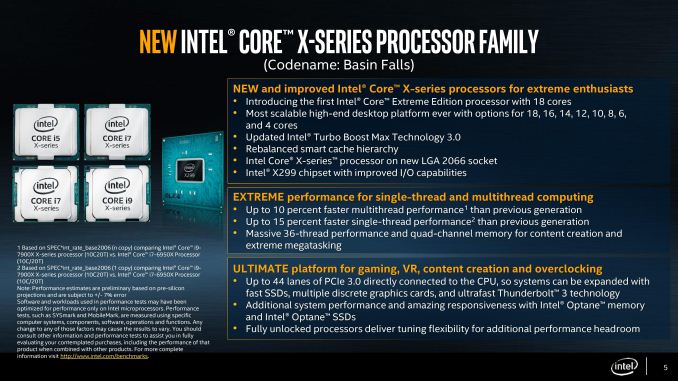Intel Announces Skylake-X: Bringing 18-Core HCC Silicon to Consumers for $1999
by Ian Cutress on May 30, 2017 3:03 AM ESTAnnouncement Four: AVX-512 & Favored Core
To complete the set, there are a couple of other points worth discussing. First up is that AVX-512 support coming to Skylake-X. Intel has implemented AVX-512 (or at least a variant of it) in the last generation of Xeon Phi processors, Knights Landing, but this will be the first implementation in a consumer/enterprise core.
Intel hasn’t given many details on AVX-512 yet, regarding whether there is one or two units per CPU, or if it is more granular and is per core. We expect it to be enabled on day one, although I have a suspicion there may be a BIOS flag that needs enabling in order to use it.
As with AVX and AVX2, the goal here is so provide a powerful set of hardware to solve vector calculations. The silicon that does this is dense, so sustained calculations run hot: we’ve seen processors that support AVX and AVX2 offer decreased operating frequencies when these instructions come along, and AVX-512 will be no different. Intel has not clarified at what frequency the AVX-512 instructions will run at, although if each core can support AVX-512 we suspect that the reduced frequency will only effect that core.
With the support of AVX-512, Intel is calling the Core i9-7980X ‘the first TeraFLOP CPU’. I’ve asked details as to how this figure is calculated (software, or theoretical), but it does make a milestone in processor design. We are muddying the waters a bit here though: an AVX unit does vector calculations, as does a GPU. We’re talking about parallel compute processes completed by dedicated hardware – the line between general purpose CPU and anything else is getting blurred.
Favored Core
For Broadwell-E, the last generation of Intel’s HEDT platform, we were introduced to the term ‘Favored Core’, which was given the title of Turbo Boost Max 3.0. The idea here is that each piece of silicon that comes off of the production line is different (which is then binned to match to a SKU), but within a piece of silicon the cores themselves will have different frequency and voltage characteristics. The one core that is determined to be the best is called the ‘Favored Core’, and when Intel’s Windows 10 driver and software were in place, single threaded workloads were moved to this favored core to run faster.
In theory, it was good – a step above the generic Turbo Boost 2.0 and offered an extra 100-200 MHz for single threaded applications. In practice, it was flawed: motherboard manufacturers didn’t support it, or they had it disabled in the BIOS by default. Users had to install the drivers and software as well – without the combination of all of these at work, the favored core feature didn’t work at all.
Intel is changing the feature for Skylake-X, with an upgrade and for ease-of-use. The driver and software are now part of Windows updates, so users will get them automatically (if you don’t want it, you have to disable it manually). With Skylake-X, instead of one core being the favored core, there are two cores in this family. As a result, two apps can be run at the higher frequency, or one app that needs two cores can participate.
Availability
Last but not least, let's talk about availability. Intel will likely announce availability during the keynote at Computex, which is going on at the same time as this news post goes live. The launch date should be sooner rather than later for the LCC parts, although the HCC parts are unknown. But no matter what, I think it's safe to say that by the end of this summer, we should expect a showdown over the best HEDT processor around.


















203 Comments
View All Comments
Drumsticks - Tuesday, May 30, 2017 - link
If it's not too late, Ian, can you follow up with Intel on whether Skylake-X is soldered? Kaby Lake-X is, but it's at least KIND OF (read: not) understandable since they're based off of Kaby Lake. Are the Skylake-X parts different?Bullwinkle J Moose - Tuesday, May 30, 2017 - link
Yeah, I'd like to see someone justify an 18 core processor with software currently availableIf the performance of your graphics software falls of a cliff after 6 or 8 cores, then 18 cores will never be used
or
If you only use over 10 cores say once a month, you'd be much better off financially by keeping an older multicore around for the odd job when needed
dullard - Tuesday, May 30, 2017 - link
How about someone who crunches numbers for a living but who cannot justify a $100,000+ server?http://www.ansys.com/Solutions/Solutions-by-Role/i...
http://www.ansys.com/Solutions/Solutions-by-Role/i...
Gothmoth - Tuesday, May 30, 2017 - link
VM´s, streaming... there are a lot of multitasking cases where a 18 core makes sense.Flunk - Tuesday, May 30, 2017 - link
Not really, both of those cases would be better served by more, cheaper boxes. Unless you mean game streaming and then you don't need that many cores anyway (6 is more than enough, you just need 1 more than the majority of people).Icehawk - Tuesday, May 30, 2017 - link
In our IT environment, and many others, the goal is to reduce to a minimum the physical number of boxes required and run as much virtualized. Although if we are talking any reasonable desktop usage, yeah this stuff is way overkill except for a few usage cases.Gothmoth - Sunday, June 4, 2017 - link
in any sane environment that´s the goal.Gothmoth - Sunday, June 4, 2017 - link
more boxes?why should you be willing to buy more PSU´s, more peripherals overall waste space when you can run it in one box?
not to mention maintenance of many systems instead of one.. i guess you have no clue how the reality looks, sorry.
haukionkannel - Tuesday, May 30, 2017 - link
Something interestinghttps://m.youtube.com/watch?feature=youtu.be&v...
Intel is using bublegum in all these prosessors. Maybe we will get upgraded tin versions next year at upgraded prices ;)
Morawka - Wednesday, May 31, 2017 - link
Just wow.. It's called Lead Free Solder intel!!!!!!! You can still use solder and still be environmentally friendly (that's been intel's excuse for the paste)